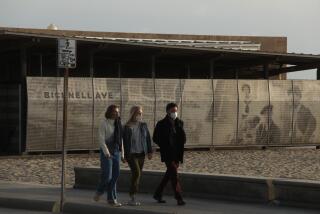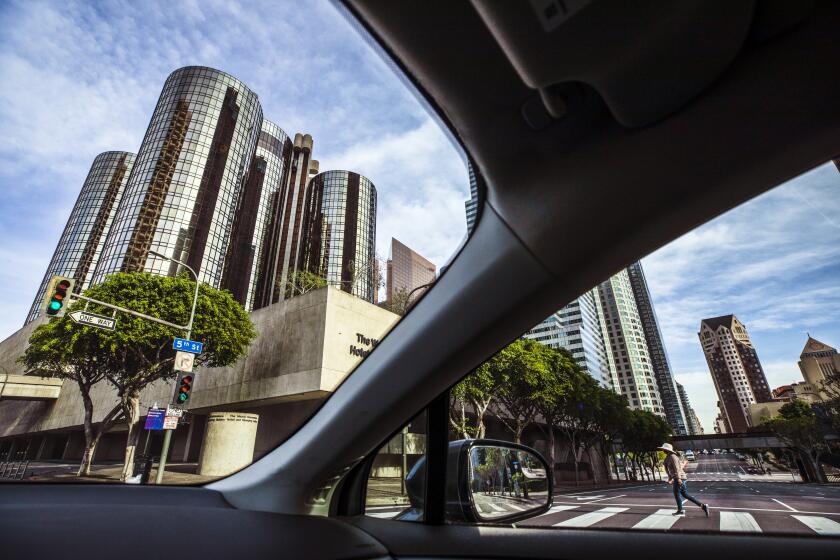Historic Stops on Boston’s Black Heritage Trail
BOSTON — The soldiers’ faces are solemn, their gazes straight ahead, as they stride forward shouldering rifles and flags. From the drummer boy in the lead to the infantrymen barely visible through the tightly packed ranks, they wear a look of unswerving determination.
Cast in bronze by Augustus Saint-Gaudens, the figures represent men of the Massachusetts 54th Regiment of Volunteer Infantry, the first black regiment to fight in the Civil War. Their story inspired the feature film “Glory,” and the statue raised in their memory, standing in a corner of Boston Common, marks the starting point for a unique walking tour of Boston--the Black Heritage Trail.
The 1.6-mile walk leads to the African Meeting House where the volunteers enlisted, and to the unassuming brick house that was a key, clandestine station on the Underground Railroad for fugitive slaves.
For armchair travelers, these two important stops on the Black Heritage Trail will be covered by documentaries airing on the KPBS series “The American Experience.” Tomorrow night’s episode is “Roots of Resistance--a Story of the Underground Railroad”; on Feb. 18 is “The 54th Colored Infantry.”
For visitors to Boston, these and other stops along the trail will offer a view of 19th-Century American history that has been largely overlooked. Home of the famous Freedom Trail, which guides visitors to 16 historic sites of the American Revolution, Boston also offers a walking tour of 14 stops along the African-American quest for freedom.
Although Africans were brought to Boston as slaves as early as 1638, a free black community took root in the next century. At the end of the Revolutionary War, free blacks outnumbered slaves in Massachusetts, which abolished slavery in 1783. The population of Beacon Hill’s black community peaked at about 2,000 before the Civil War, when it struggled to protect people from the terror of the Fugitive Slave law and organized to end slavery in the rest of the country.
The Black Heritage Trail was designated a National Historic Site in 1980. National Park Service tours gather at a corner of Boston Common, where Saint-Gaudens’ sculpture stands across Beacon Street from the State House.
On the tour I joined, a Park Service ranger began by providing a historical context for the story of the 54th--the first of the 186,000 black troops (nearly 10% of the Union Army) that helped turn the tide against the Confederacy.
The 54th Regiment was raised in 1863, when President Lincoln granted a request by the governor of Massachusetts to form a company of black soldiers in Boston. The ranks filled quickly with volunteers--free blacks and fugitive slaves, aged 16 to 60. The white commanding officer of the 54th Regiment, Col. Robert Gould Shaw, tried to win for his men equal supplies, pay and the opportunity to fight.
Among America’s finest works of 19th-Century public art, the memorial to Shaw and the 54th Regiment took Saint-Gaudens 14 years to complete. At its dedication ceremony in 1897, survivors of the 54th marched again through Boston. Among them was Sgt. William H. Carney, Jr., who, though wounded, saved the American flag from capture at Fort Gagner, S.C., by wrapping it around his body. Sadly, Carney’s bravery, for which he received the first Medal of Honor awarded to a black, went unrecognized in “Glory.”
Near the memorial stands the home of another black military hero, George Middleton, who served as a colonel in the Revolutionary War, leading an all-black company called the “Bucks of America.”
Like other homes on the trail, the Middleton House is a private residence and is closed to the public, but its historic appearance is preserved. Built by blacks in 1797, this clapboard house stands on what was once commonly acknowledged as the “black side,” of Pinckney Street, which divided the Hill’s black and white communities.
In the 19th Century, Beacon Hill’s African Americans often challenged the line drawn between the races. The 1824 Phillips School, at the next corner, is one of two schools on the trail that witnessed early efforts to combat racial discrimination in Boston’s educational system.
Continuing along Pinckney Street, we caught a glimpse of the Charles River, then stopped at a Federal-period town house with an arched fanlight over the door. This was the home of John J. Smith, a black man born free in Virginia in 1820. Although his trip in 1849 to California’s gold fields brought neither fame nor fortune, Smith made a name for himself in Boston, where his barbershop was a hub of black abolitionist activity and a rendezvous for fugitive slaves.
Smith went to Washington during the Civil War to recruit men for the all-black Fifth Cavalry and later turned to a career in politics, serving in the Massachusetts House of Representatives and the Boston Common Council. Despite his standing in the community, he met resistance when he tried to buy a home on the “white side” of Pinckney Street.
Integration also affected church affairs in the neighborhood. In 1878, a black congregation purchased the Charles Street Baptist Church, where years before a church member had been expelled for bringing black friends into his pew. The congregant, Timothy Gilbert, later joined other Baptist abolitionists to found what became Tremont Temple, the nation’s first integrated church.
As important as it was, the community’s struggle for social equality was overshadowed by the physical dangers resulting from the Fugitive Slave law, which authorized the federal government to return runaway slaves to their Southern owners. The law meant black fugitives were no longer safe on Boston streets.
Beacon Hill residents reacted swiftly: Black and white abolitionists formed a secret Vigilance Committee to resist the law and conceal runaway slaves in a network of safehouses.
Boston’s most active station on the Underground Railroad was an unassuming brick house on Phillips Street. It was the home of Lewis Hayden, a former slave who himself had followed the abolitionists’ secret route to freedom. Committed to bettering the lives of other blacks, he became a respected leader in the abolitionist movement and a principal “conductor” on the Underground Railroad.
It is said Hayden kept two kegs of gunpowder in his basement, threatening he would blow up his home before he would surrender the ex-slaves harbored there. On a visit to Boston in 1853, Harriet Beecher Stowe, author of “Uncle Tom’s Cabin,” was taken to this house where she encountered 13 fugitives.
Next on the trail is the center of the post-Revolutionary black community: Smith Court. Here stand the African Meeting House, the Abiel Smith School and a cluster of houses that offer a glimpse into the lives of blacks who raised families, worked as tradespeople and established independent institutions in Boston.
Smith Court is a mix of brick-and-wood houses, some free-standing, others with common walls. A laborer named George Washington purchased No. 5 in 1849. The house at No. 10 was built in 1853 for a chimney sweep who owned 15 properties when he died. The oldest house dates to 1790. In the 1850s one of its boarders was William C. Nell, America’s first published black historian and a leader in the movement to integrate Boston’s public schools.
Frustrated by the state’s refusal to let their children attend public schools, black parents opened a community school in a private home at Smith Court in 1798. By 1835, the community had its own building: Smith School. Funded by the legacy of a white businessman, the school served African-American children from all over Boston until it was boycotted during the fight to end public school segregation.
The issue erupted in the 1840s when a black parent sued the city for unlawfully denying his daughter public school instruction. The ruling of the state’s Supreme Judicial Court--which found Smith School instruction not inferior to that in other Boston schools--was cited more than 100 years later by the U.S. Supreme Court in the landmark case, Brown versus Board of Education.
Perhaps the most important building in Smith Court is the African Meeting House. Dedicated in 1806, this handsome brick meeting house is the oldest African-American church building still standing in the U.S.--a credit to the black artisans who constructed it. Today, the meeting house reflects renovations of the 1850s, when its windows were elongated and doors were moved to accommodate a pair of stairways that spiral to the balcony.
The African Meeting House was the spiritual heart of Boston’s 19th-Century black community, a center of worship, education and political activity. The New England Anti-Slavery Society was formed here by William Lloyd Garrison in 1832. During the abolitionist period (when women’s rights were also championed), the meeting house became known as “the Black Faneuil Hall.” The voices of Frederick Douglass, Wendell Phillips and Charles Sumner rang from its podium.
Before leaving, I lingered over pictures of anti-slavery leaders, a poster exhorting black Bostonians to keep “top eye out” for slave catchers, and a copy of a vigilance Committee ledger from 1859, which lists among its expenses “an artificial leg for Johnson H. Walker, a fugitive slave from Maryland,” and “passage from Portland to Canada.”
In the gallery below the sanctuary, a special exhibition focused on the 54th Regiment, mustered here in the African Meeting House. Those who joined the ranks--as well as others of Boston’s black community who fought for freedom and dignity--are beginning to receive the recognition they deserve. Walking the Black Heritage Trail is a step in the right direction, a way of opening our eyes to their courage and commitment.
More to Read
Sign up for The Wild
We’ll help you find the best places to hike, bike and run, as well as the perfect silent spots for meditation and yoga.
You may occasionally receive promotional content from the Los Angeles Times.






